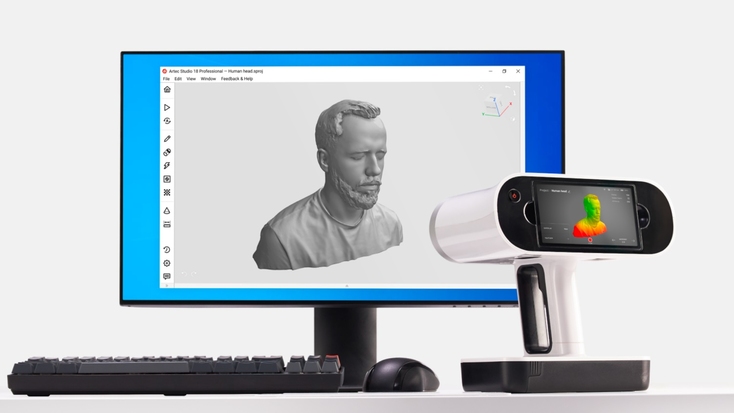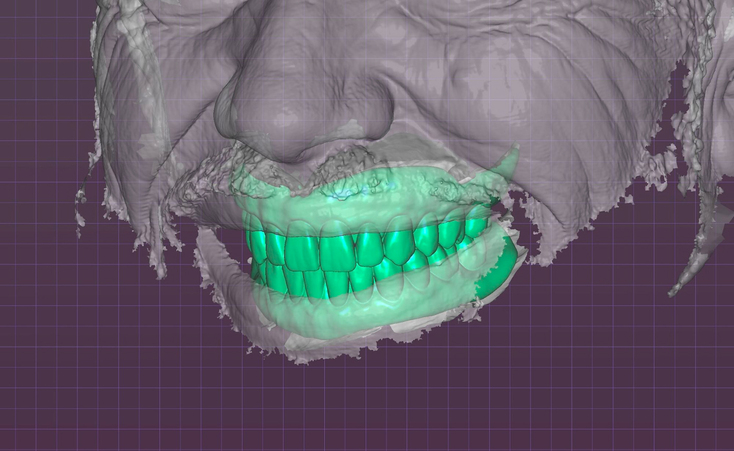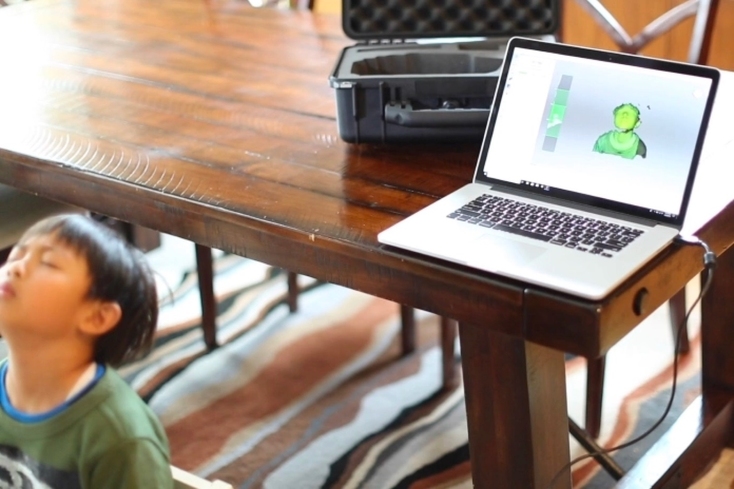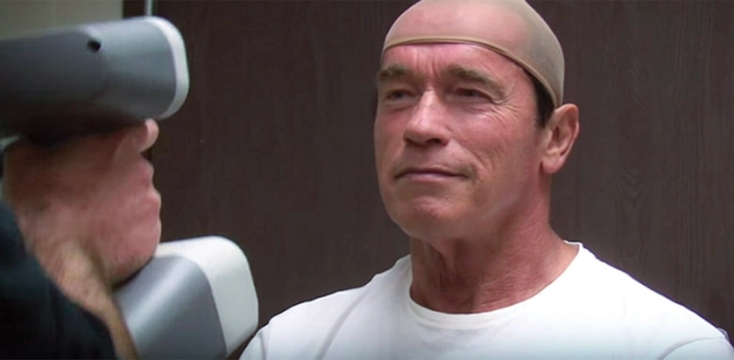What’s the best 3D face scanner in 2024?
With the proliferation of modern camera-equipped smartphones, it’s now easier than ever to 3D scan someone’s face, to create a virtual avatar or for 3D printing into novelty items. But face scanning isn’t just for having fun. Upgrade to a professional-grade device and suddenly you can create ultra-accurate face models with real world applications.

Scanning faces with Artec Leo allows quick, easy, and accurate data capture
Many face scanning technologies are now so ingrained in our daily lives, we don’t even notice them. Need a dental implant? Your clinic may well scan your mouth. Got a new iPhone? It’ll feature face authentication. Seen realistic-looking TV or movie animations recently? It’s entirely possible you were marveling at CGI made with 3D face scanning.
If you’d like to learn more about how the technology can be used for more than just having fun, read on. We’ll break down how it works, when you should consider upgrading to a professional 3D face scanner, and where it’s already used in the industry.
Face scanning: not just a novelty
At face value, 3D scanning someone may seem like a bit of fun. Get your smartphone out, download an app, take photos of a friend’s face, and apply amusing effects to the resulting 3D model. You may even go as far as exporting this for 3D printing so you can turn them into a figurine. But dig deeper and you’ll find the technology can be used to achieve far more.
3D face scanning continues to address real world use cases. It’s not always well publicized, but many of us already use the technology every day. If you’ve bought an iPhone since 2017, it’ll have FaceID, a feature built around Artec 3D scanning algorithms that checks your face against a scan database, before granting or denying device access.
Key point
Smartphones are great for playing around with but for anything more, you’ll need a professional 3D scanner.
Not only present in smartphones, 3D face scanning is also advancing in other industries. In CGI, for example, studios have begun using the technology to digitize actors, and turn them into movie or video game characters. Due to their sheer accuracy, higher-end devices can also be used in healthcare, for face or body orthosis customization.
Even the White House has adopted the technology, using a photorealistic 3D scan of President Barack Obama to create the first 3D presidential portrait of a US leader.
Of course, not all 3D face scanners are built equally, and some applications will be out of reach for those just toying with the technology. So, let’s start by taking a look at what you can achieve with consumer devices, before moving onto more serious scanners.
Smartphones as 3D scanners
With all modern smartphones now featuring high-resolution cameras and app compatibility, face scanning and recognition technologies have gone from niche to mainstream.
As with professional scanners, the level of 3D model detail you can achieve with a smartphone depends on the process, hardware, and software you use. If you’ve bought an iPad Pro since 2020 or got an iPhone 12 Pro or later, your device will have two cameras installed: a TrueDepth camera for FaceID and a light detection and ranging or LiDAR one.
While the former projects thousands of infrared dots onto someone’s face to analyze and create a depth map of their features, LiDAR is more general purpose. The technology works by measuring the time taken by a pulsed laser to bounce back off an item’s surface. With LIDAR and apps like Scaniverse or Polycam, you can digitize anything from a household object to the human face in high resolution – albeit with limited geometry capture.
Android hardware differs by model; many of the same apps work on these handsets, but camera resolution will impact mesh sharpness and detail. If you’re willing to toy with other gadgets, Xbox Kinect cameras can also be repurposed as scanners. They capture likenesses better than smartphones, but with less accuracy and precision than professional devices.
Key point
While smartphone scans capture vibrant colors, they lack fine detail. Remove texture and instead of seeing a face you’ll be left with a featureless mannequin.
It is possible to optimize smartphone scans by doing a few things. First, you should ensure wherever you’re scanning is evenly lit, so shadows don’t ruin your results. Once you’re set up, it’s best to walk around the person being digitized, scanning them from ear-to-ear. You should also make sure they sit on or stand in front of something monochromatic, so your camera’s depth sensors can more easily differentiate between face and background.
Naturally, however, there are limitations to what you can achieve with smartphone cameras. They enable the creation of vibrantly colored, 3D face replicas, but these don’t feature sufficient geometry data for anything beyond having fun.
How does photogrammetry fit in?
If your smartphone doesn’t feature LiDAR, you can still digitize the human face, albeit with photogrammetry instead of 3D scanning. Using any camera, it’s possible to take multiple overlapping photos of a person or object from different angles, before generating a textured 3D mesh via dedicated software. However, hardware is also bound to influence results.
While smartphone photogrammetry can yield acceptable meshes, it’s worth switching to a mirrorless camera or a DSLR one with swappable lenses if you need anything more. Not only do advanced cameras work better in difficult lighting conditions, they offer more focus options.
You only need to take a look at the quality of photogrammetry models in CGI – an industry where you’re unlikely to find smartphone capture – to see the difference.
That said, however you use the technology, capturing dozens of photos is going to take a few minutes, making it slower than 3D scanning. If deployed in capture booth form, it’s going to be much bulkier too, so when it comes to photogrammetry vs 3D scanning in CGI, the latter clearly wins on speed and convenience.
Best professional 3D scanners
Artec Eva
Nowadays, plenty of professional 3D scanners are built to address certain use cases, but if you’re looking for a face scanning all-rounder you can’t go wrong with Artec Eva. Weighing 900 grams, the structured light scanner is heavier than a smartphone, but still lighter than many competitors, and maneuverable enough for fast, effortless feature capture.

The versatile Artec Eva in use with essential medical applications
Eva scans faces in as little as 5-10 seconds, but where it really trumps photogrammetry is resolution. Capable of capturing fine facial details as small as 0.2 mm, the device yields textured models that closely reflect peoples’ anatomies. If you’re only scanning to create display items, this may not be worth investing in, but in areas like medical, it’s essential.
Turkey’s AVSAR Aesthetic Surgery Clinic is a prime example of this. There, Dr. Avşar makes plastic surgery masks with 3D scanning which accurately demonstrate how patients will look after procedures. Previously, crafting masks was laborious and they lacked detail, leaving the clinic vulnerable to claims that surgeries didn’t achieve advertised results. But, since Avşar adopted Eva, his patients have been able to make better-informed decisions.
Artec Leo
When it comes to combining Eva’s accuracy with the speed and freedom of phone scanning, the more advanced structured light Artec Leo offers a unique alternative. The only wireless AI-powered scanner on the market, Leo captures likenesses with greater precision than consumer devices, while maintaining the same point-and-shoot functionality.
Key point
Artec Leo & Eva capture far higher resolution face scans than smartphones – this means they can be used in serious medical applications.
Alongside its built-in display, this makes the device easier to adopt than other professional 3D scanners, which tie users to a computer with cables. With a scan speed of 35 million pts/s, it’s also faster than any of its handheld rivals, allowing it to digitize faces in a handful of seconds.
This rapid pace isn’t achieved at the expense of fine detail capture either. With HD Mode on, Leo can capture the tiniest facial features at a resolution of just 0.2 mm, and deliver stunningly realistic scans. Activating this mode also allows for facial hair reconstruction – smartphones tend to struggle more here, resulting in face models with foamier-looking beards.
Artec Space Spider
When working to ultra-fine tolerances in areas like medical planning, dental implant production, and archeological digitization, the 0.05 mm accuracy, 0.1 mm resolution blue light-powered Artec Space Spider is the ideal solution.

Face scanning allows dental practitioners to fit their work in the context of the surrounding areas of the face
Key point
Space Spider captures fine facial details like eye contour depth, nose shape, and skin imperfections with incredible precision.
Digitizing human faces may take slightly longer than with Eva or Leo, but what’s 40 seconds when you get 3D models so realistic, you can see the smallest bumps and wrinkles on peoples’ faces? The proof is already out there – alongside Eva, VFX experts have used the device to create a spookily lifelike CGI character for TV series Sleepy Hollow.
In the field of heritage research, Space Spider has also reconstructed the face of a 10,000-year-old man, doing so with incredible accuracy. While his remains were found over 100 years ago, only the advent of technologies like Space Spider have allowed the Mesolithic caveman to be faithfully recreated, and displayed in museums across Europe.
Artec Studio
Designed to make high-resolution Artec 3D scanning quick and easy, Artec Studio is the ideal professional-grade scan data capture and processing companion. If you’re new to face scanning, the software’s Autopilot is great for automating many traditionally manual editing steps, and it can ultimately get you from scan-to-mesh in as little as 1-2 minutes.

Quick capture and excellent algorithms are important, especially when working with children!
With Artec Studio, you can also combine scans from different devices. In practice, this allows you to rapidly capture someone’s face with Eva or Leo, then merge that data with a higher resolution Space Spider scan in a single click, to achieve more realistic results.
When it comes to scanning moving objects like faces, Artec Studio also has an ace up its sleeve. The software’s algorithms compensate for the small movements that are hard to avoid when scanning people – especially fidgeting children who are tricky to keep still.
Elsewhere, the program harnesses AI to capture fine details like blemishes, while its HD Mode (available with Leo and Eva) makes it easier to digitize notoriously difficult to scan hair. If you need to create especially vibrantly colored 3D face models, Artec Studio even allows scans to be combined with photogrammetry, to realize textures that truly pop.
Before we get into applications, let’s take a look at face scanning technique, and how to get the best possible results.
How to 3D scan a face
Your wider workflow will differ depending on the technology used. Smartphone LiDAR scanning is often as simple as downloading an app and following instructions. Though it yields lower quality meshes, the process itself is similar to that of professional 3D scanning: positioning someone before walking around them, digitizing their face as you go.
This core workflow means there are certain steps you can take to improve results across the board. Before you start, ensure whoever’s being digitized is sat an equal distance from the nearest light source to prevent shadows, and it’s worth leaving around 1.5 meters of space.
To limit the changing of facial expressions, get them to focus on a point just above their line of sight, and don’t forget to remind them not to talk or laugh. If your volunteer wears glasses, it’s best to remove them as they’ll reflect scanner light. You can always digitize any facial accessories separately and add them later.
Once you begin, it’s best to scan quickly to limit expression change, going from ear to ear, tilting as needed, while digitizing each area once. With high-end devices, you can then go on to capture detailed body scans in seconds, or switch straight to editing – Artec Studio features an array of editing tools that allow you to align multiple scans to account for slight twitches.
If in doubt, just remember to ask the person being scanned:
- To focus on a point just above their line of sight
- Take a stable, comfortable pose (to minimize movement)
- Not to laugh and try not to move their face – quick scans help here!
- Remove attire like glasses, they can always be added later
- To relax while you scan ear-to-ear, then around the head in an arc motion
Remember: only scan each part of the face once, as facial muscles are highly vulnerable to movement!
Whether you use phone or high-end camera images, many of these tips can be applied in photogrammetry too, where lighting and background are also likely to impact quality. That said, you’ll not only have to tackle these issues, but deal with lens calibration, blur, and image overlap – problems that can be bypassed with professional 3D scanning.
Key point
The faster you digitize someone’s face, the fewer issues you’ll have. Speed and technique are of the essence; this is where Artec 3D scanners excel.

Capturing facial data allows applications such as monitoring facial movement and expressions
Applications
Facial recognition
It may not be the first face scanning application that comes to mind, but facial recognition is by far the most prevalent. Since 2011, smartphone developers have steadily rolled out facial recognition as a security feature. Typically powered by AI, the technology works by checking the features of someone’s face against a virtual scan database.
As well as verifying accounts, the technology’s used as a tool for identifying potential clients by social media and marketing firms. In the US, facial recognition is also increasingly finding airport security applications, helping law enforcers locate problematic passengers while ensuring regular travelers can get on with their journey.
Digital shopping
In the retail sector, human face and body scanning is helping overcome one of online shopping’s biggest drawbacks: not being able to try things on. Apps like Wearfits combine 3D scanning with AR so customers can see how things look when worn. Many opticians have now integrated similar technologies into their websites for trying on glasses as well.
Though it hasn’t quite become mainstream and many software platforms feature basic tracking that’s easy to lose, retail virtualization continues to take steps forward. Already, some retailers offer glasses frame suggestions based on facial feature analysis, and no doubt advances in AI will see others adopt the technology to boost online sales.
Key point
Not many realize, but 3D scanning is central to the features of everyday smartphones and online shopping sites.
CGI
3D scanning also continues to thrive as a means of creating incredibly lifelike CGI for video games, TV shows, movies, and more. Instead of designing certain characters, props, or environments from scratch, building them from scans is much faster and allows creatives to deliver audiences more immersive experiences.
In one such case, Californian VFX specialist FXTC has deployed Space Spider 3D scanning to create stunningly lifelike CGI for The Walking Dead. The resulting full-color, high-resolution scans of props and actors’ faces were used to bring the show’s set to life, and in one episode, realize the producers’ vision for a gruesome amputation scene.
Other high-profile CGI applications include Arnold Schwarzenegger’s Terminator face scan – which went on to feature in Terminator Genisys. Eva user TNG Visual Effects has also worked on special effects for all sorts of franchises ranging from Twilight to Superman.

Many famous faces have been captured with Artec 3D scanners
Medical & dental
In clinical settings, 3D scanning is a powerful non-contact tool for accurately customizing medical devices and dental implants to patients’ anatomies. Burn victims, for instance, can be fitted with protective masks without having to go through painful plaster casting.
Professional 3D scanning is also thriving in craniofacial surgery. One innovator, Dr. Sheryl Lewin, is utilizing the ultra-precise Space Spider for creating custom microtia ear implants. Thanks to the device’s speed and resolution, she’s now able to make grafts perfectly match patients’ healthy ears, and implant them in a way that causes less discomfort.

In the medical industry, Artec Space Spider provides hope to a wide range of patients
Similarly, precision face scanning continues to prove popular among dentists. At the Center for Implant Dentistry, aligning dental implants with 3D scanning has become part of their daily care routine. Switching from photography and intraoral scanning to Space Spider capture has allowed the practice to offer patients smile previews at a greater pace and accuracy.
Archeology
Not just for scanning the faces of the living, professional devices are being deployed by archeologists and forensic analysts to digitize the dead. For UK-based Face Lab researchers, Space Spider is allowing them to bring historic figures to life for new audiences.
In one case, the device’s full-color, high accuracy scans have uncovered the face of Robert the Bruce, and models of the Scottish king can now be found at museums across Europe. Similarly, in the US, researchers have been able to approximate the Bronze Age ‘Griffin Warrior’s’ appearance with 3D scanning, after his grave was found 3,500 years post-mortem.
Forensics
When it comes to forensics, face scanning can also be used to help police investigators uncover clues at crime scenes. Digitizing victims’ bodies and other forensic evidence with submillimeter accuracy allows them to go back, analyze it long after it has been cleared away, and use it to support prosecutions.
In fact, professional scanners can capture the gaps between teeth with such precision, researchers are experimenting with using them for bite mark analysis. As bite marks aren’t admissible as evidence in many courts, the technology has the potential to shake up this forensic field, and bring closure to many victims.
Key point
Professional 3D scanners capture facial features with such accuracy, they’re utilized in clinics, forensics, and archeology.
What next for face scanning?
Facial recognition remains at the forefront of 3D face scanning and the technology continues to find new applications in this area. Already used by the TSA to identify passengers in the US, it’s increasingly finding its way into bank authentication, and with 1.3 billion devices set to feature facial recognition by 2024, the consumer market is growing exponentially.
Away from phone capture, professional-grade face scanning is also starting to address a greater number of medical, forensic, and CGI-related niches. More accurate than both smartphone scanning and photogrammetry, Artec devices address the needs of advanced users, whether they work in animation, archeology, or at a clinical practice.
So, where does the technology go from here? Professional 3D scanning represents such a step up on other face capture technologies, it’s bound to continue finding new use cases anywhere where speed and precision are of the essence.
More from
the Learning center
From custom prosthetics to perfectly fitted clothes, and 3D-printed figurines to realistic game avatars, 3D body scanners are rapidly gaining traction across industries. In this article, we explore the main challenges behind capturing the human body, the different scanner types, and how the technology is driving innovation in medical, sports, clothing, CGI, and more.
3D models are everywhere. Used widely across industries, they’re now behind many of the physical objects we encounter in day-to-day life. In this guide we’ll cover the most popular 3D modeling methods, from designing a model from scratch to digitizing a physical object with a 3D scanner.
With advanced technologies like AI, VR, and 3D scanning increasingly being integrated into manufacturing, the line between the physical and virtual has never been blurrier, leading some to say that we are living through a Fourth Industrial Revolution. At the core of this ‘Industry 4.0’ overhaul is the ‘Digital Twin,’ a virtual copy of a part, asset, system, or process that can be used to track or improve performance. In this article, we explain how these twins are made, where they are being applied, and the opportunities they could unlock.



